Shenzhen, Guangdong, China – Wednesday, May 25th, 2011
Shenzhen is the birthplace of the Chinese Theme Park. We have the Overseas Chinese Town Enterprises (or OCT) to thank. With the establishment of Shenzhen as China’s first Special Economic Zone, OCT opened Splendid China in 1989, featuring miniatures of Chinese culture and landmarks. It was followed by the China Folk Culture Village in 1991 (more Chinese culture), and Window of the World in 1994 (more miniature landmarks). The crowning glory came in 1998 with Happy Valley Shenzhen, the company’s first Happy Valley park for which there would eventually be eight across the nation. Happy Valley Shenzhen would become the prototype for the wave of nearly all themed Chinese parks with mega rides in the subsequent decades… and all the good and bad that entails.
What makes a modern Chinese theme park? Theming follies can be quite big and impressive. Story, however, is close to non-existent. The park design will for some time seem competently realized, but then you’ll see something deeply confusing. This will happen a couple of times throughout the day. The berm will consist of identical high rises. There will be a section required for the “Chinese cultural quota” (and then you’ll realize American parks do the exact same thing for American culture). There will be cute and/or creepy cartoon mascots. Operations will be awful. The food will be awful. Somewhere, maybe out in the open or in a dark alley, a Disney IP character will be aggressively infringed upon. There will be nothing you can do to help.
So it goes for Chinese theme parks, so it all began here at Happy Valley Shenzhen.
 I’ll get this out of the way first: Bullet Coaster, the park’s then-new S&S Launch Coaster, would not be open in time for my visit.
I’ll get this out of the way first: Bullet Coaster, the park’s then-new S&S Launch Coaster, would not be open in time for my visit.
While construction appeared to be finished and they even had the trains on the track, it was not open to the public yet. It might have been frustrating if I only “just” missed it, but with hindsight I was nowhere close. Apparently it didn’t open to the public until July of 2012, a full 14 months after my visit.
What they were doing to it during that time I don’t know. Five years later I would get to try the other prototype model that opened at Happy Valley Beijing, and indeed thought it was pretty good. The layouts are pretty different so I’d still love to give this one a try someday, if not at Shenzhen then perhaps the clone at Happy Valley Wuhan that opened in 2014.
While it doesn’t have the reverse-banked curve that was the highlight of Beijing’s Extreme Rusher, Shenzhen’s Bullet Coaster does have what appears to be a lot of delicious twisting airtime moments along its out-and-back style layout. The sideways banked “wave turn” appears to be this ride’s own unique highlight, installed two years before the maneuver made its U.S. debut on Outlaw Run. Plus the setting and thematic design appears quite a bit nicer in Shenzhen than Beijing’s or Wuhan’s versions.
The biggest excitement came later in the day when the train was pushed out onto the launch track. Even if it wasn’t going to open, I’d at least hoped to catch a test run on camera. Nothing ever came of it, however.
With Bullet Coaster not happening, the roster of attractions at Happy Valley Shenzhen appeared considerably less appealing. Located in the park’s Himalayan section, Bullet Coaster stands directly over what as of 2011 was still the park’s largest thrill ride, Snow Mountain Flying Dragon.
This Vekoma SLC opened in 2002 as the original “Shenlin” model, either with or without extra helix. (This one was without.)
Much of what I said about Dragon in Clouds at Happy Valley Chengdu a few months prior also applies to this one. This ride is older and bit rougher, lacking the final helix. But the scenic design is a bit nicer with water and trees surrounding the layout. I was generous to ride this one twice.
A big reason for that was the absolutely insane loading procedure. I’d seen a version of this done at Happy Valley Chengdu, but it was extra absurd here. After very slowly assigning every row on the platform while the empty train waits, the operator finally leads the entire group in a stretching exercise before boarding. I’m pretty sure this is of very minimal if any help against the risk of pulled muscles (for an experience we spend the whole time in a sitting position), but it does do a heck of a lot to torpedo efficiency and make what would normally be a five minute wait for three ride cycles into a nearly half-hour endurance test. Still, the video is pretty amusing.
Some more shots of Snow Mountain Flying Dragon in action. As you can tell, the cobra roll is pretty much the only element that has clear visibility from within the theme park.
As noted eariler, it wouldn’t be a Chinese theme park without some deeply troubling characters. I believe these entities were part of the Himalayan section.

 Unique to Happy Valley Shenzhen is the presence of an old western themed section, Gold Mine Town. Western themes are common at American and even European theme parks, so when building the first Happy Valley park in China it makes sense that they would look to imitate those models. Happy Valley often copies theme concepts from park to park, so the fact that only one other Happy Valley park ever imitated the western theme suggests they found it wasn’t as popular with a Chinese audience.
Unique to Happy Valley Shenzhen is the presence of an old western themed section, Gold Mine Town. Western themes are common at American and even European theme parks, so when building the first Happy Valley park in China it makes sense that they would look to imitate those models. Happy Valley often copies theme concepts from park to park, so the fact that only one other Happy Valley park ever imitated the western theme suggests they found it wasn’t as popular with a Chinese audience.
Despite the best attempts by the theme designers to create an “immersive” style experience, there are numerous factors outside their control working against that goal.
Mine Town Audio Room appeared to be another one of those “spooky headphone listening” experiences that are for whatever reason popular at Chinese theme parks. I don’t have any recollection of giving this one a try.
Also as was noted earlier: theming in the parks can make some very large statements, but it rarely tells a cohesive story. Are these bronze bulls an acknowledgement that the entire Gold Mine Town is an artistic representation?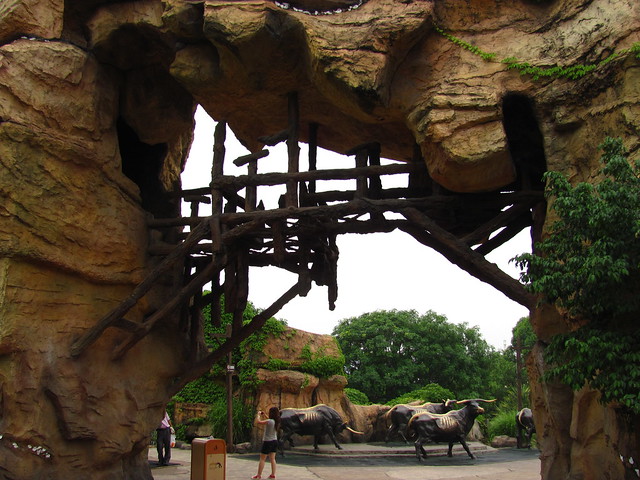
 When you want your fake crow to also go “caw caw.”
When you want your fake crow to also go “caw caw.”
And at the other end of Gold Mine Town, this marquee is confusing for a couple reasons. Why is the land now called “Gold Mine Mountain”? And why is there a stone giant with an enormous pick-ax rising from the ground?
 Whether it’s Gold Mine Town or Gold Mine Mountain, the main attraction is the Gold Mine itself, home to the creatively named Mine Coaster.
Whether it’s Gold Mine Town or Gold Mine Mountain, the main attraction is the Gold Mine itself, home to the creatively named Mine Coaster.

 Clearly inspired by Big Thunder Mountain, Mine Coaster is the first of many of the Vekoma dual-lift style mine train coasters to be built across China (with the majority of them now produced by Vekoma’s “competitors” at Golden Horse). Interestingly, Shenzhen’s is just about the only mine train coaster that has an actual western mine train theme. Nearly all the others have some more distinct customized theme, which is honestly pretty cool, if occasionally a bit weird.
Clearly inspired by Big Thunder Mountain, Mine Coaster is the first of many of the Vekoma dual-lift style mine train coasters to be built across China (with the majority of them now produced by Vekoma’s “competitors” at Golden Horse). Interestingly, Shenzhen’s is just about the only mine train coaster that has an actual western mine train theme. Nearly all the others have some more distinct customized theme, which is honestly pretty cool, if occasionally a bit weird.
Unlike Big Thunder Mountain there’s no animatronics or even any real show scenes along the layout. Just rocks and other mining detritus as the coaster aimlessly weaves back and forth. It doesn’t even have the satisfaction of a classic Arrow Dynamics mine ride of getting to wander and explore the terrain, as the mountain landscape is all empty inside. There’s honestly very little that I remember from this ride, even though it by far ended up being the attraction that I rode the most that day, as the sole full-sized coaster that wasn’t actively unpleasant.
It was around my fourth or fifth lap that I realized that I probably didn’t need to schedule so much time for Happy Valley, especially knowing that Bullet Coaster wouldn’t be open. If I could have planned it today I might have spent a couple of those hours checking out another of the non-ride parks nearby, like Splendid China.

 But since I did give myself the entire afternoon at Happy Valley before starting an evening ticket at Window of the World across the street, I might as well explore it thoroughly. Continuing the tour…
But since I did give myself the entire afternoon at Happy Valley before starting an evening ticket at Window of the World across the street, I might as well explore it thoroughly. Continuing the tour…
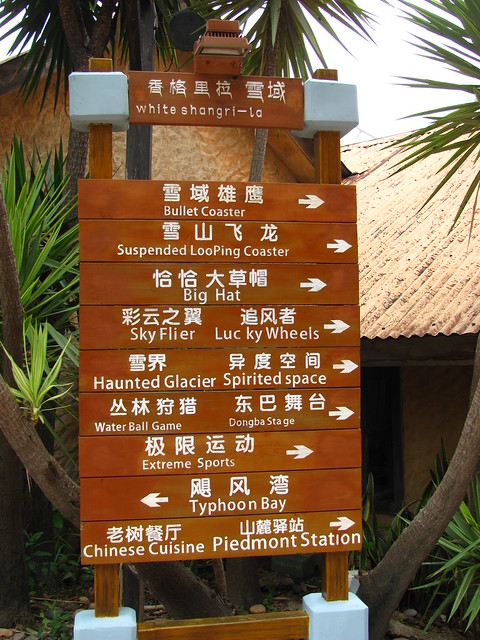 One other unique feature of Happy Valley Shenzhen is a heavily-wooded hillside you can wander around, I believe called “Mt. Adventure.” This is one quality that is definitely not like other Chinese theme parks, which are unvaryingly flat and, due to their newness, have virtually no mature foliage.
One other unique feature of Happy Valley Shenzhen is a heavily-wooded hillside you can wander around, I believe called “Mt. Adventure.” This is one quality that is definitely not like other Chinese theme parks, which are unvaryingly flat and, due to their newness, have virtually no mature foliage.
A rapids ride also meanders this mountain.
“Tunnel Warfare” and “Climbing in the Forest”: English translations of Chinese attraction names are inevitably either completely literal or dadaist.
At the top of the mountain was this S&S tower, positioned with some optimal views overlooking the park.
Heading back down the mountain, this area feels more like a public park than a theme park.
Topiaries ahead. I feel like I’m wandering one of those sprawling RollerCoaster Tycoon park scenarios.
Wild Elfin is the park’s requisite Golden Horse spinning mouse coaster. Despite supposedly having an elf theme, the cars are decorated like eagles.
Despite their ubiquity in China I haven’t had the best track record so far with two of the previous three being closed for my visit. At least now I’d be on track for a 50/50 success rate.
In 2015 this coaster was permanently closed as well. I have no idea what, if anything, it was replaced with.
Baby Coaster was supposed to be my final coaster of the day, a Beijing Shibaolai Amusement Equipment “Big Apple/Wacky Worm” style kiddie coaster.
At first the safety guide seemed to indicate that adults were okay to ride. (Also, a 5-star motion index for a Wacky Worm? How fast do they have the lift hill cranked up?)
But then, while I’m not sure what this sign said, at the other end of it I found a ride that was not in a state of functionality. Oh well. Apart from the extra count, not a huge loss. (Although I still could have walked straight onto the platform and hopped in the ride car if I wanted to.)
The ants are a fixture of any Happy Valley park. In case you’re wondering “why ants as a children’s mascot?” Remember that this park opened the same year as A Bug’s Life and Antz.
Check out the Magic Theater, where, like me, you too can be part of an audience of five in a big empty theater watching a magic and variety show starring giant alien ants!
Or wander this creepy ant-infested abandoned hallway…
Inside you’ll find what may have unexpectedly been the best ride in the park that day: North Pole Adventure. (Covered by another giant black ant, of course.)
This is a Sally interactive dark ride of a merry Christmastime journey in search of presents with Santa and his happy little elves…
…whom you will hunt down with your bright orange revolvers.
I’m not sure if the nightmarish Krampus vibes were intended by this dimly-lit yuletide shooting spree. Presumably the guns were a default model that the client declined to pay to customize, however well-advised that would have been. Regardless, North Pole Adventure stands alone as easily the most original attraction found at Happy Valley Shenzhen.
A quick tour of the rest of Happy Valley Shenzhen’s offerings, beginning with this surprisingly epic canyon river for what’s a small family scenic boat ride.
 I couldn’t be certain what this dinosaur-themed facade was for (or even recall what part of the park it was in). Was it the boat ride? A different dark ride? Something else? Whatever it was, the slow-moving line out front meant I didn’t attempt to find out.
I couldn’t be certain what this dinosaur-themed facade was for (or even recall what part of the park it was in). Was it the boat ride? A different dark ride? Something else? Whatever it was, the slow-moving line out front meant I didn’t attempt to find out.
 This large train ride touring the park is another one of those elements common to American and European theme parks, but has rarely been copied over by newer Chinese theme parks since.
This large train ride touring the park is another one of those elements common to American and European theme parks, but has rarely been copied over by newer Chinese theme parks since.
 It seems like every Happy Valley park has a carnival themed section where they can slug in a bunch of big loud flat rides with minimal theming effort. In that way at least we can see how Happy Valley shares design philosophies with Disney parks such as California Adventure and Animal Kingdom.
It seems like every Happy Valley park has a carnival themed section where they can slug in a bunch of big loud flat rides with minimal theming effort. In that way at least we can see how Happy Valley shares design philosophies with Disney parks such as California Adventure and Animal Kingdom.

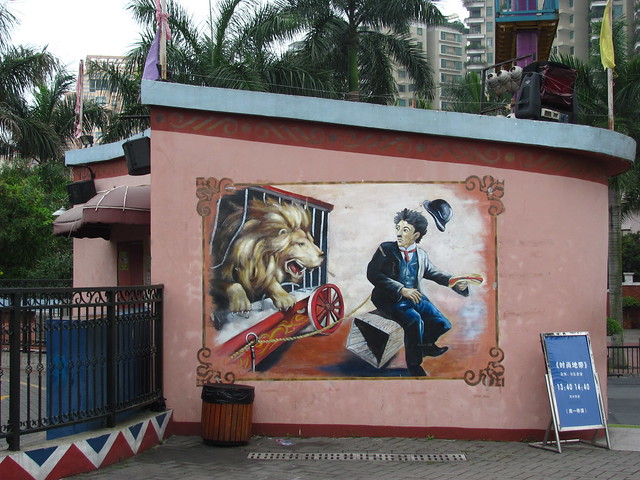


 Typhoon Bay anchors the western side of the park, surrounding this large water feature.
Typhoon Bay anchors the western side of the park, surrounding this large water feature.
Speaking of confusing themes, here’s an old Cadillac growing straight out of an ancient watchtower. Whatever the original intent was, something got lost in translation.
The Shoot-the-Chute, similar to the Mine Coaster, is a much repeated ride design that nevertheless features very different themes at each location. The cargo container aesthetic of this version is not the most beautified of the bunch.
This Huss Top Spin had just finished testing, and with a name like The Perfect Storm how could I pass it by?
While the ride itself was basically fine, I recall some challenges with the operational procedures that resulted in us waiting here for unnecessarily long as the lady glared at us for some (unknown to me, at least) reason. And I’m pretty sure this was at the exit, not the entrance!
 While that was all Happy Valley Shenzhen had to offer me in 2011, the park has continued to expand in the years since. Obviously Bullet Coaster’s debut in 2012 was and continues to be the big draw for coaster enthusiasts; the park also added a Mack PowerSplash in 2019, and as of 2011 was also in the process of adding the large Playa Maya water park, complete with an uphill water coaster.
While that was all Happy Valley Shenzhen had to offer me in 2011, the park has continued to expand in the years since. Obviously Bullet Coaster’s debut in 2012 was and continues to be the big draw for coaster enthusiasts; the park also added a Mack PowerSplash in 2019, and as of 2011 was also in the process of adding the large Playa Maya water park, complete with an uphill water coaster.


 If I had to rank the four Happy Valley parks I’ve been to, Shenzhen would be at the bottom of the list, mostly due to the coaster selection. Looking past the coasters, however, and there’s more to like about the park, relative to the rest of the Chinese theme park market. 1998 isn’t very old for a theme park, but it is old enough that it’s starting to get a sense of its own history, a quality that’s conspicuously lacking from most of the newer parks that barely measure a decade old. Maybe I’ll be back someday, if not only for Bullet Coaster.
If I had to rank the four Happy Valley parks I’ve been to, Shenzhen would be at the bottom of the list, mostly due to the coaster selection. Looking past the coasters, however, and there’s more to like about the park, relative to the rest of the Chinese theme park market. 1998 isn’t very old for a theme park, but it is old enough that it’s starting to get a sense of its own history, a quality that’s conspicuously lacking from most of the newer parks that barely measure a decade old. Maybe I’ll be back someday, if not only for Bullet Coaster.

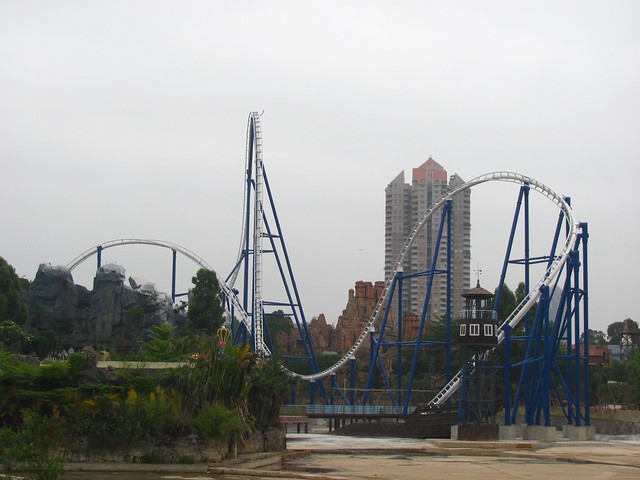





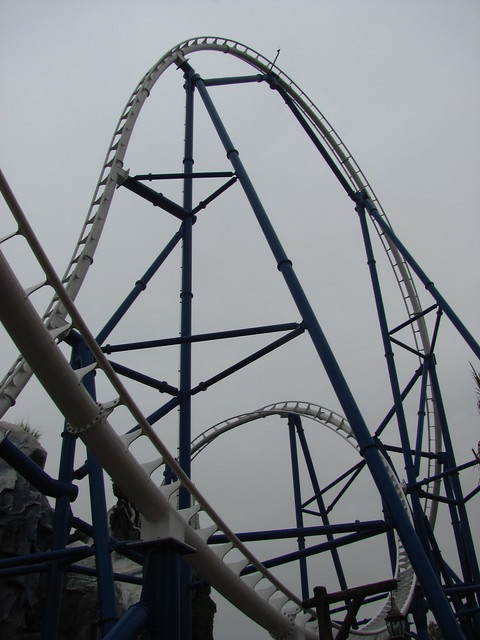







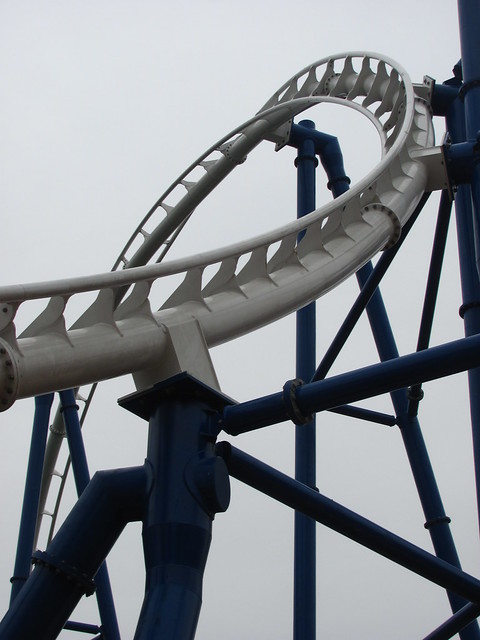























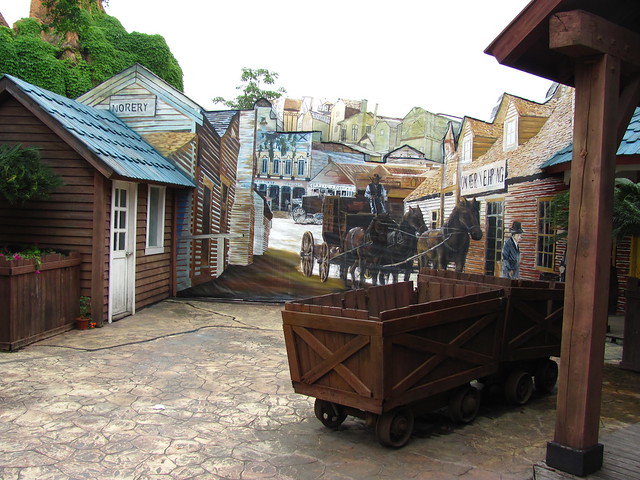






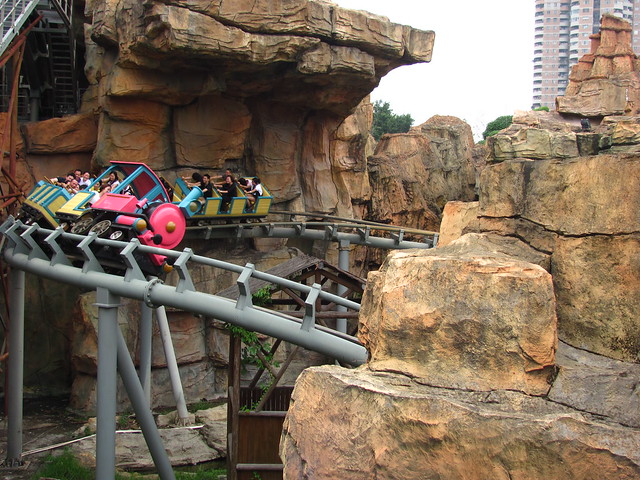





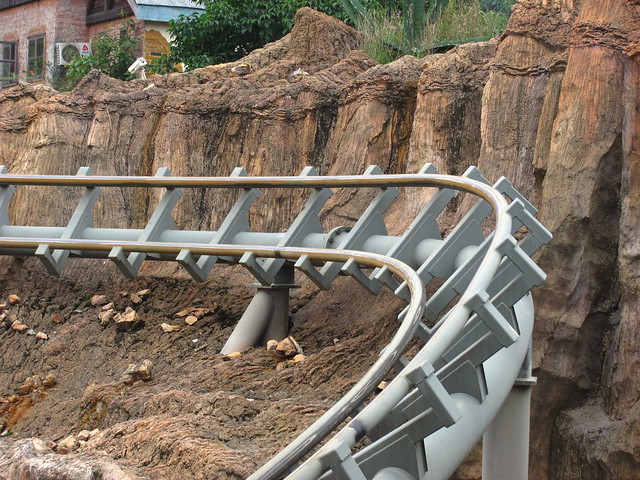





























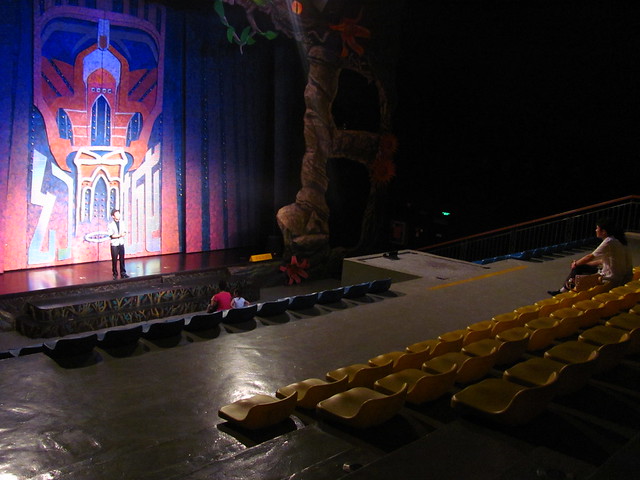


















Comments